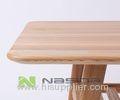|
Shenzhen Nasida Furniture Company Limited
|
Glass Replica Isamu Noguchi Coffee Table
| Place of Origin: | Zhejiang, China (Mainland) |
|
|
|
| Add to My Favorites | |
| HiSupplier Escrow |
Product Detail
Glossy Glass
Glossy Glass Replica Isamu Noguchi Coffee Table with Solid Wood Base , 12mm - 19mm
Quick Details
- Type: Living Room Furniture
- Specific Use: Coffee Table
- General Use: Home Furniture
- Material: Wooden + Glass
- Appearance: Modern
- Folded: No
- Size: 130*91*41
- Place of Origin: China (Mainland)
- Brand Name: Nasida
- Model Number: TL001
- Material Quality: Solid wood + Glass
Description:
Isamu Noguchi Coffee Table
Item No. : TL001
1. Thickness of tempered glass of the coffee table available: 12mm, 15mm,19mm
2. Color of solid wood base of the oval coffee table available: natural, light walnut, dark walnut,black
Specifications:
|
Product Name: |
Isamu Noguchi Coffee Table TL001 |
|
|
Designer: |
Isamu Noguchi |
|
|
Product No.: |
TL001 |
|
|
Product Material: |
full Ash solid wood material |
|
|
Upholstery Material: |
full Ash solid wood |
|
|
Available Colors: |
Black, white, red, brown and so on. |
|
|
Product Dimension (cm): |
130×91×41 |
|
|
Package: |
K=K Carton |
K=K Carton |
|
Packing Size (cm): |
138×100×7( table Top); 98×45×10 (table legs) |
|
|
Single CBM: |
0.14 |
|
Designer introduction:
|
Isamu Noguchi |
|
|
In the early 1930s he travelled to China and Japan, where he studied many aspects of oriental arts and crafts. In 1935 he designed sets for the choreographer Martha Graham’s ballet Frontier, working on further sets for Martha Graham productions in the 1940s. Noguchi’s first furniture designs in rosewood and glass were for A. Conger Goodyear, the president of the Museum of Modern Art, New York, in 1939. Following in the spirit of his sculptures earlier in the 1930s, these were biomorphic in character. His furniture for Herman Miller included a glass-topped coffee table (designed c.1940), a rocking stool (c.1953), and a Formica-topped dining table using cast iron and steel rods to support its top (c.1953). Noguchi also produced an aluminium table for Alcoa in 1957. From the mid-1940s he produced a series of table lamps for Knoll that took on something of the qualities of Japanese lanterns with simple translucent "shades" wrapped around simple geometric frames. Following a visit to Japan in 1951 he also began to explore the aesthetic possibilities of folding paper lanterns that were first produced under the name of Akari in the early 1960s. |
|

















